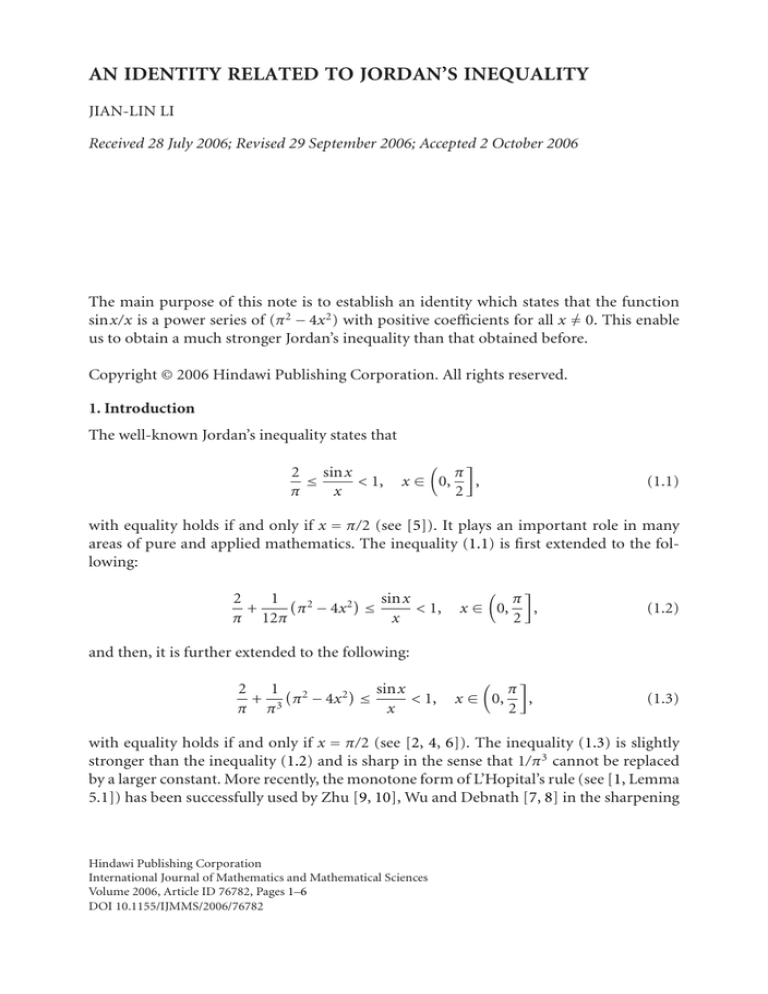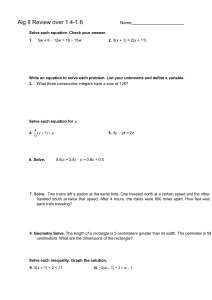
AN IDENTITY RELATED TO JORDAN’S INEQUALITY
JIAN-LIN LI
Received 28 July 2006; Revised 29 September 2006; Accepted 2 October 2006
The main purpose of this note is to establish an identity which states that the function
sinx/x is a power series of (π 2 − 4x2 ) with positive coefficients for all x = 0. This enable
us to obtain a much stronger Jordan’s inequality than that obtained before.
Copyright © 2006 Hindawi Publishing Corporation. All rights reserved.
1. Introduction
The well-known Jordan’s inequality states that
2 sinx
≤
< 1,
π
x
x ∈ 0,
π
,
2
(1.1)
with equality holds if and only if x = π/2 (see [5]). It plays an important role in many
areas of pure and applied mathematics. The inequality (1.1) is first extended to the following:
sinx
1 2
2
π − 4x2 ≤
+
< 1,
π 12π
x
x ∈ 0,
π
,
2
(1.2)
and then, it is further extended to the following:
sinx
2 1 2
+ 3 π − 4x2 ≤
< 1,
π π
x
x ∈ 0,
π
,
2
(1.3)
with equality holds if and only if x = π/2 (see [2, 4, 6]). The inequality (1.3) is slightly
stronger than the inequality (1.2) and is sharp in the sense that 1/π 3 cannot be replaced
by a larger constant. More recently, the monotone form of L’Hopital’s rule (see [1, Lemma
5.1]) has been successfully used by Zhu [9, 10], Wu and Debnath [7, 8] in the sharpening
Hindawi Publishing Corporation
International Journal of Mathematics and Mathematical Sciences
Volume 2006, Article ID 76782, Pages 1–6
DOI 10.1155/IJMMS/2006/76782
2
An identity related to Jordan’s inequality
Jordan’s inequality. For example, it has been shown that if 0 < x ≤ π/2, then
sinx
2 1 2
2 π −2 2
≤ +
π − 4x2 ,
(1.4)
+ 3 π − 4x2 ≤
3
π π
x
π
π
12 − π 2 2
2 sinx
π −3 2
2
2 1
2 1 2
π − 4x2 ≤
≤ + 3 π 2 − 4x2 +
π − 4x2
+ 3 π − 4x2 +
π π
16π 5
x
π π
π5
(1.5)
hold with equality if and only if x = π/2. Furthermore, the constants 1/π 3 and (π − 2)/π 3
in (1.4) as well as the constants (12 − π 2 )/(16π 5 ) and (π − 3)/π 5 in (1.5) are the best.
Also, in the process of sharpening Jordan’s inequality, one can use the same method as
did in [7] to introduce a parameter θ (0 < θ ≤ π) to replace the value π/2. Unfortunately,
the preceding method will become cumbersome to execute in the further generalization
of Jordan’s inequality.
In this note we establish an identity which states that the function sinx/x is a power
series of (π 2 − 4x2 ) with positive coefficients for all x = 0. This enables us to obtain a
much better inequality than (1.4) or (1.5) if 0 < x ≤ π/2.
2. Main result
The main result relating to Jordan’s inequality is contained in the following.
Theorem 2.1. For any x > 0, the following identity
∞
k
sinx 2 (−1)k Rk 2
= +
π − 4x2
x
π k=1 k!π 2k
(2.1)
holds, where
2n
∞
(−1)n n!
π
Rk =
(2n
+
1)!(n
−
k)!
2
n =k
(2.2)
satisfying (−1)k Rk > 0 (k = 1,2,3,...).
√
Proof. Let x = π 2 − t/2 and t = π 2 − 4x2 . It follows from the Taylor expansion for sin x
that
∞
sin (π 2 − t)/2 (−1)n π 2 − t
=
(2n + 1)!
4
(π 2 − t)/2
n =0
n
− ∞ < t < π2 .
(2.3)
Since
π2 − t
n
= π 2n +
n
(−1)k n! 2(n−k) k
t
π
k!(n − k)!
k =1
(n = 1,2,3,...),
(2.4)
Jian-Lin Li
3
we see that
2n
∞
(−1)n
π
sin (π 2 − t)/2
=
1
+
2
(2n
+
1)!
2
(π − t)/2
n =1
+
∞
(−1)n (−1)k n! 2(n−k) k
t
π
(2n + 1)!4n k=1 k!(n − k)!
n =1
n
2n
∞
∞
2 (−1)n
π
(−1)k k
n!
= +
t
π k=1 n=k (2n + 1)! (n − k)! 2
k!π 2k
∞
=
2 (−1)k Rk k
t
+
π k=1 k!π 2k
− ∞ < t < π2
(2.5)
which yields(2.1) with Rk given by (2.2).
n
Let Rk = ∞
n=k (−1) cn,k with
cn,k =
π 2 /4 π 2 /4
1 π 2 /4 π 2 /4
···
.
(n − k)! n + 1 n + 2 n + 3
n + n 2n + 1
1
(2.6)
Then for each given k (k = 1,2,3,...),
(n ≥ k),
cn,k > cn+1,k ,
Hence the alternating series
∞
n=k (−1)
nc
n,k
Rk = (−1)k
lim cn,k = 0.
n→∞
(2.7)
converges, and its sum
∞
(−1) j ck+ j,k
(2.8)
j =0
satisfies (−1)k Rk > 0 and |Rk | < ck,k for each given k (k = 1,2,3,...). This completes the
proof of the theorem.
Next we give a formula of calculating Rk . Let
dk (x) =
∞
(−1)n n!
x2n .
(2n
+
1)!(n
−
k)!
n =k
(2.9)
Then
x sinx x3 1 sinx ,
d2 (x) = 2
,...,
2 x
2 x x
x2k−1 1 1
1 sinx dk (x) = k
···
···
2
x x
x x
d1 (x) =
(2.10)
with kth derivative, and
x
dk+1 (x) = −kdk (x) + dk (x) (k = 1,2,3,...).
2
(2.11)
4
An identity related to Jordan’s inequality
Hence Rk = dk (π/2) with
π
1
=− ,
2
π
π
−3(10 − π 2 )
,
R3 = d3
=
2
8π
R1 = d1
π
12 − π 2
,
=
2
8π
π
π 4 − 180π 2 + 1680
R4 = d4
.
=
2
128π
R2 = d2
(2.12)
Also the above established identity (2.1) gives
12 − π 2 2
2
sinx 2 1 2
= + 3 π − 4x2 +
π − 4x2
x
π π
16π 5
4
10 − π 2 2
π 4 − 180π 2 + 1680 2
2 3
+
π
−
4x
+
π − 4x2
7
9
16π
3072π
∞
(−1)k Rk 2
k
+
π − 4x2
k!π 2k
k =5
(2.13)
for all x > 0. Since (−1)k Rk > 0 (k = 1,2,3,...), we have the following corollary.
Corollary 2.2. If 0 < x ≤ π/2, then
12 − π 2 2
2
sinx 2 1 2
≥ + 3 π − 4x2 +
π − 4x2
x
π π
16π 5
4
10 − π 2 2
π 4 − 180π 2 + 1680 2
2 3
+
π
−
4x
+
π − 4x2
16π 7
3072π 9
(2.14)
holds with equality if and only if x = π/2. Furthermore, the constants 1/π 3 , (12 − π 2 )/(16π 5 ),
(10 − π 2 )/(16π 7 ), and (π 4 − 180π 2 + 1680)/(3072π 9 ) in (2.14) are the best.
The above established inequality (2.14) is much stronger than the left-hand side of
inequality (1.5). Also one can add more positive terms to the right-hand side of inequality
(2.14) to get higher accuracy.
Finally, it should be pointed out that, in order to give the right-hand side of inequality
(1.4) or (1.5), the following Taylor expansion for x/ sinx will play an important role as
the above established identity (2.1) or (2.13).
Taylor expansion of x/ sinx.
∞
22n − 2 2n
x
=
(−1)n+1 B2n
x
sinx n=0
(2n)!
1
7 4
31 6
= 1 + x2 +
x +
x + ···
6
360
15120
(2.15)
|x| < π ,
where B2n are the Bernoulli numbers satisfying (−1)n+1 B2n > 0 (n = 1,2,3,...).
Recall that the Bernoulli numbers Bn and the functions Bn (x) are defined by
t
et
−1
=
∞
Bn
n =0
n!
∞
tn
Bn (x)
text
=
tn
t
e − 1 n=0 n!
|t | < 2π .
(2.16)
Jian-Lin Li
5
It is familiar that they have the following properties (see [3, Section I-13]):
B0 (x) = B0 = 1,
−1
1
1
,
B2 = ,
B4 =
,
B6 = ;
2
6
30
42
(−1)n+1 B2n > 0, Bn (0) = Bn (n ≥ 1);
B1 =
B2n+1 = 0,
−1
Bn (1 − x) = (−1)n Bn (x)
(2.17)
(n ≥ 1);
∞
B2n (x) =
2(−1)n+1 (2n)! 1
cos(2πrx)
(2π)2n
r 2n
r =1
(n ≥ 1, 0 ≤ x ≤ 1),
from which, we have
B2n−1
1
= 0,
2
2n
2 B2n
1
= 2 − 22n B2n
2
(n ≥ 1).
(2.18)
Therefore, for |x| < π,
∞
2xiexi
1 2 n in n
x
= 2xi
=
Bn
x
sinx e − 1 n=0
2 n!
=
∞
B2n
n =0
∞
1 (−1)n 22n 2n 22n − 2 2n
x = (−1)n+1 B2n
x .
2
(2n)!
(2n)!
n =0
(2.19)
From (2.15), we have the following type of strengthened right-hand Jordan’s inequality:
sinx
1
7 4
31 6
≤ 1 + x2 +
x +
x
x
6
360
15120
−1
|x| < π .
(2.20)
Also one can add more positive terms to the right-hand side of inequality (2.20) to get
higher accuracy.
Acknowledgment
The author would like to thank the referees for their valuable suggestions.
References
[1] G. D. Anderson, S.-L. Qiu, M. K. Vamanamurthy, and M. Vuorinen, Generalized elliptic integrals
and modular equations, Pacific Journal of Mathematics 192 (2000), no. 1, 1–37.
[2] L. Debnath and C.-J. Zhao, New strengthened Jordan’s inequality and its applications, Applied
Mathematics Letters 16 (2003), no. 4, 557–560.
[3] A. Erdélyi, Higher Transcental Functions, Vol. I, McGraw-Hill, New York, 1953.
[4] A. McD. Mercer, U. Abel, and D. Caccia, A sharpening of Jordan’s inequality, The American Mathematical Monthly 93 (1986), 568–569.
[5] D. S. Mitrinović and P. M. Vasić, Analytic Inequalities, Springer, New York, 1970.
[6] A. Y. Özban, A new refined form of Jordan’s inequality and its applications, Applied Mathematics
Letters 19 (2006), no. 2, 155–160.
[7] S. Wu and L. Debnath, A new generalized and sharp version of Jordan’s inequality and its application to the improvement of Yang Le inequality, Applied Mathematics Letters 19 (2006), no. 12,
1378–1384.
6
An identity related to Jordan’s inequality
[8]
, A new generalized and sharp version of Jordan’s inequality and its application to the improvement of Yang Le inequality II, to appear in Applied Mathematics Letters.
[9] L. Zhu, Sharpening Jordan’s inequality and the Yang Le inequality, Applied Mathematics Letters
19 (2006), no. 3, 240–243.
, Sharpening Jordan’s inequality and Yang Le inequality. II, Applied Mathematics Letters
[10]
19 (2006), no. 9, 990–994.
Jian-Lin Li: College of Mathematics and Information Science, Shaanxi Normal University,
Xi’an 710062, China
E-mail address: jllimath@yahoo.com.cn









